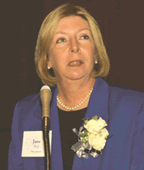Economics about the Environment
To promote interdisciplinary research and education
March 1, 2007
By Pam McLaren
Whether it’s a forecast on what the economic environment holds for the region, an indicator reflecting the trends in economic activity or a study into the health and related economic benefits of improved air in the San Joaquin Valley, there’s one place at Cal State Fullerton where a business leader, elected official or interested consumer can find the answers: the Institute for Economic and Environmental Studies.
The center, first called the Environmental Institute, was established in 1990 to promote interdisciplinary research and education, and to distribute information about the environment. Its first project was to study the city of Fullerton’s solid waste output to help the municipality prepare a source reduction and recycling program.
It has since delved into the effect of recession and the North American Free Trade Agreement (NAFTA) on Orange County, and studies of the impact of air pollution in various regions of California. Researchers under its auspices have looked at the role of defense spending in the Orange County economy — and the economic impact of the closure of the El Toro Base.
“It really is important to understand the larger implications of alternative decisions regarding things like land use and regulation,” said Jane Hall, co-director of the institute and professor of economics. “Researchers at IEES help both to frame issues in terms of the alternatives and to assess the consequences of taking or not taking action.”
Since 1994, the Institute provides an annual economic forecast of what the state, county and region can expect in job growth, inflation, energy costs, imports and exports, consumer spending, investment and housing.
“The Institute’s forecasts are extensively used by the business community and the public sector in their annual planning,” said Anil Puri, dean of the College of Business and Economics and co-director of the institute. He has provided the forecast since its inception with specialized reports created by other faculty members in the college. “Now the County of Orange, Orange County Transportation Authority and Southern California Association of Governments also rely on these projections, which have proved to be fairly accurate.”


 Produced by the Office of Public Affairs at California State University, Fullerton.
Produced by the Office of Public Affairs at California State University, Fullerton.